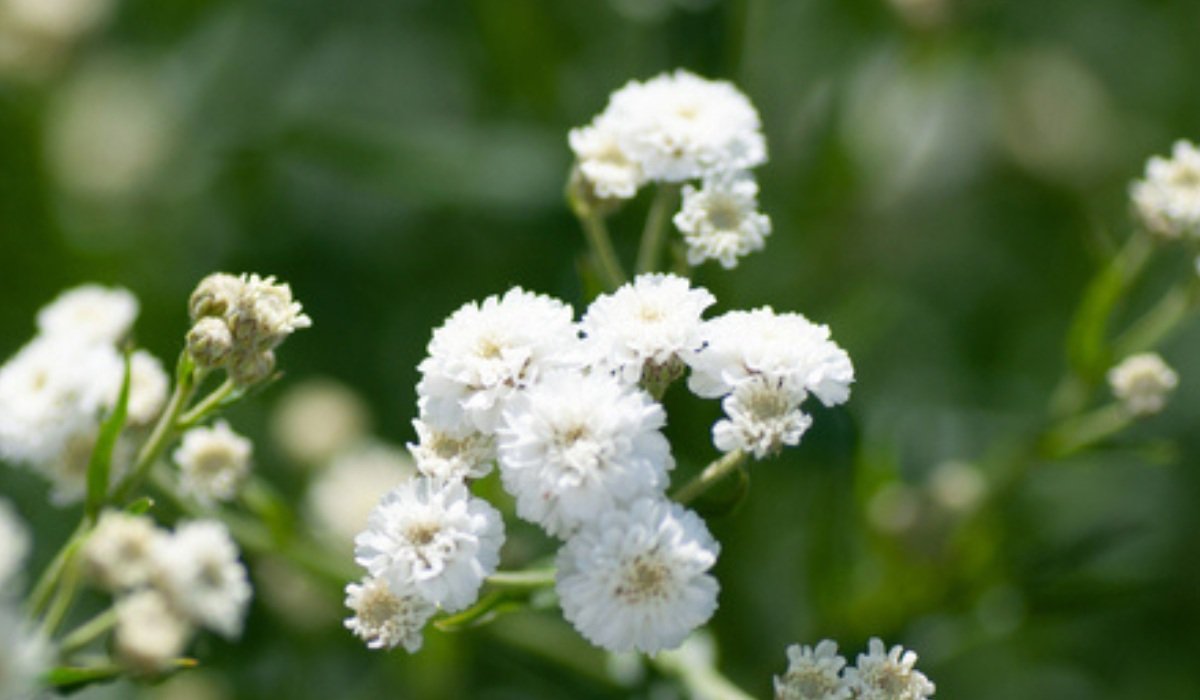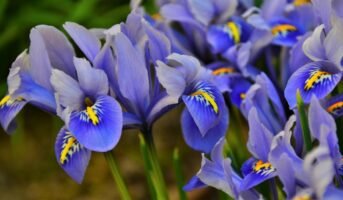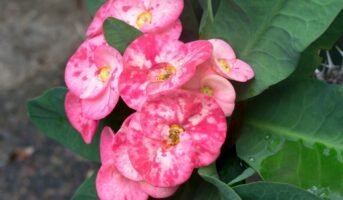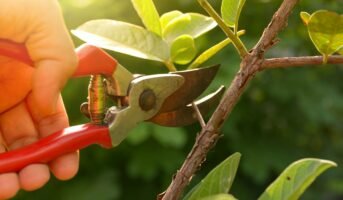Gypsophila elegans is commonly known as baby’s breath because of its airy, profusely branching inflorescence and thousands of tiny flowers. It is utilised in dry bouquets as well as flower arrangements with roses and other species with huge flowers. The species is indigenous to the steppes of a region that runs from central and eastern Europe to central Asia.
Compared to the perennial type utilised by florists, the blooms are bigger and more open. It has a modest tolerance for drought and is usually seen in wildflower combinations.

Source: Pinterest
Gypsophila elegans: Facts
| Common Name | Baby’s Breath, Maiden’s Breath, Showy Baby’s Breath |
| Habitat | Anthropogenic |
| Fruit type | the fruit is dry and splits open when ripe |
| Scientific Name | Gypsophila elegans |
| Native | Eurasia |
| Growth | Up to 20 inches tall |
| Flower | Red, white and baby pink |

Source: Pinterest
Sun Tolerance
The plant requires adequate amount of sunlight to grow. Hence, it should be placed in an area exposed to full sunlight. However, it can tolerate some amount of shade during afternoons.
Mature Height
The plant can attain a maximum height of eight to 20 inches. Gypsophila plant species can reach a height of up to 36 inches.
Leaves
The leaves arrangement of Baby’s Breath plant are stalkless and opposite. That is, two leaves appear per node along the plant’s stem. The leaves have a greenish gray colour.
Cold Tolerance
Gypsophila elegans plants can tolerate light frost and can be considered frost hardy. However, they may get damaged by sudden freezes.
Growth Rate
Gypsophila elegans plants grow quite rapidly. They being to bloom in around eight weeks after germination.
Fruit
Gypsophila elegans plants produce fruits that are spherical to oblong capsules.
Flowering time
Flowers are produced around July to August.
Gypsophila elegans: The Genus
Gypsophila elegans is an ornamental plant of the Gypsophila genus, a class of flowering plants in the carnation family, Caryophyllaceae. The species is the most heterogeneous and largest groups among the carnation tribe. There are nearly 150 species of annual or perennial herbaceous, creeping or cushion-forming plants.
Gypsophila elegans: Native Habitat
The natural habitat of the plant are open areas with rich sandy or moraine soil having good drainage properties. The plant is found largely in south-western Asia. The places where the plant grows includes yards, loading areas, and waste ground.
Gypsophila elegans: How to grow?
Grow gypsophila in moist but incredibly well-drained, neutral or slightly alkaline soil for optimal results. To promote repeat blooming, routinely deadhead spent blooms. Once established, perennial plants should not be disturbed because this disturbs their roots.
Where to grow Gypsophila elegans?
Gypsophila grows best in a sunny location with free-draining soil; if neither of these conditions exists, add lots of grit when planting. Gypsophila may thrive in most neutral soils, but they prefer a slightly alkaline soil (lime or chalk).
As the plant matures, provide support for taller plants in windy areas by using pea sticks or brushwood for a more organic appearance. Feed with a general liquid fertiliser every several weeks. After flowering, prune the flower stalks to encourage a second flush of blooms in the late autumn.
How to propagate Gypsophila elegans?
Gypsophila annualis seeds should be sown directly in April or September when they will bloom because they don’t appreciate having their roots disturbed. From April till June, seed them in succession every few weeks if you’re raising them for cutting.
With only a thin layer of dirt covering them, plants will sprout from seeds quickly and can withstand a brief freeze. It is a relatively short-lived annual, barely lasting 5 to 6 weeks.
How to propagate Gypsophila elegans from cuttings?
The plant can also be grown from the cuttings of established bushes.
- Choose stem cuttings and start the process indoors. You can then transplant in your garden. Select a container with sufficient drainage holes.
- Prepare the soil. Choose well-draining soil and slightly sandy in nature. Add adequate organic matter. The soil pH must be 7 to 7.5.
- Cut the stems of length three to five inches. Remove the leaves from the lower third of every stem. For quicker results, dip the bottom of the stem in rooting hormone to promote root growth.
- Plant the cuttings by burying the lower inch in the potting soil.
- Make sure to keep the soil moist.
- After around four weeks, after the cuttings have grown, prepare an area in the garden where sunlight falls for at least six hours a day. Transplant the cutting in the garden soil, allowing a foot of space on either side for proper growth.
Gypsophila elegans: Maintenance tips
Light
Baby’s breath plants thrive in full sunlight, which means at least 6 hours of direct sunlight on most days. They will, however, tolerate some shade, particularly from the warm afternoon sun. Too much shade, on the other hand, will result in poor flowering.
Soil
Baby’s breath plants can thrive in a variety of soil types as long as there is adequate drainage. Consider planting baby’s breath in raised garden beds or containers if your soil is heavy. These plants prefer a slightly alkaline soil pH, so if your soil is acidic, lighten it with garden lime.
Water
Baby’s breath requires little water and thrives in dry soil. For young plants, keep the soil moist but not wet. Watering established plants is usually unnecessary unless there is a prolonged period of drought. Overwatering can lead to root rot and plant death.
Fertiliser
These plants aren’t heavy feeders, and using too much fertiliser can result in sluggish growth. Simply work some compost into the planting site every spring to promote healthy growth and abundant blooms.
Pruning
For a healthy plant growth, pruning is required. Dead flowers stems must be trimmed once the flowers have faded.
Pests and problems
Gypsophila must be protected against insects and pests such as grubs and caterpillars, grasshoppers, aphids, thrips and mites.
Gypsophila elegans: Uses
- In floristry, G. elegans is a popular floral filler. The light white blooms add dimension, texture, and a splash of colour.
- To use your own baby’s breath plant as a cut flower, cut stems when half of the flowers are open and add to bouquets of flowers or greenery, or simply display them on their own! To dry them for later use in arrangements, cut them early in the day and hang them upside down for at least two weeks in a dry, dark place.
- It looks lovely in small groups, in rock gardens, as a border, or between wildflower plantings.
FAQs
Can Gypsophila be grown in pots?
Yes. Gypsophila is a lovely flower for your garden pots or borders and even works well as dried flowers in addition to being terrific for cut flowers and bouquets.
How can you get Gypsophila to stop smelling?
The filler gypsophila is quite popular for bridal bouquets. If you discover that the plant has a slight odour, simply add a teaspoon of salt to make it smell better.
Is Gypsophila toxic?
Gypsophila elegans may lead to dermatitis. If you grow it at home, and if your pet ingests, it might be mildly toxic to your pets.
Housing News Desk is the news desk of leading online real estate portal, Housing.com. Housing News Desk focuses on a variety of topics such as real estate laws, taxes, current news, property trends, home loans, rentals, décor, green homes, home improvement, etc. The main objective of the news desk, is to cover the real estate sector from the perspective of providing information that is useful to the end-user.
Facebook: https://www.facebook.com/housing.com/
Twitter: https://twitter.com/Housing
Email: [email protected]











